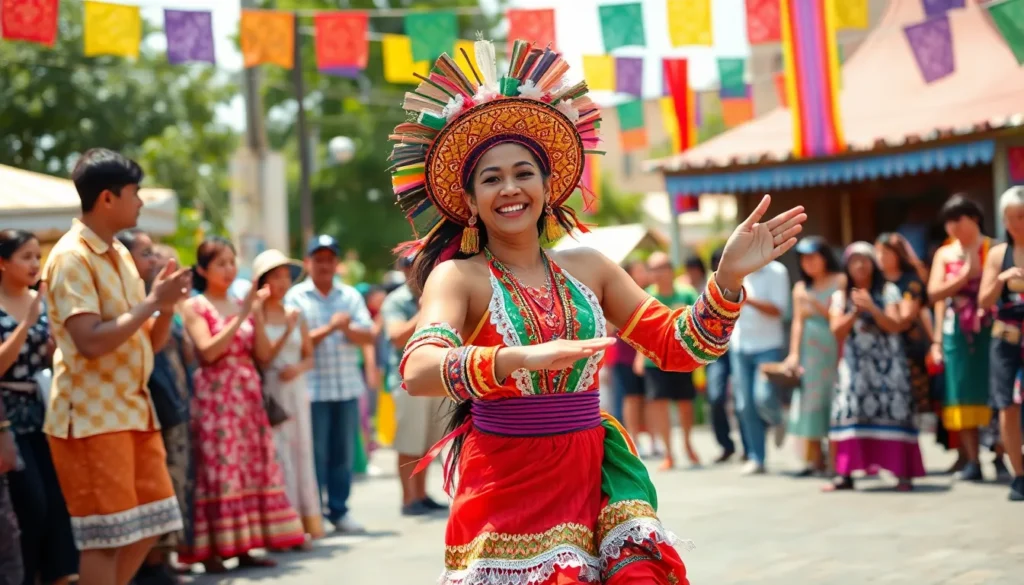Cultural dance isn’t just a series of steps; it’s a vibrant tapestry woven from history, tradition, and a dash of flair. Imagine a world where every twirl tells a story, and every rhythm pulses with the heartbeat of a community. From the spirited flamenco of Spain to the graceful hula of Hawaii, these dances capture the essence of their cultures, making them irresistible to explore.
But let’s be honest—who doesn’t want to bust a move while learning about the rich heritage behind it? Cultural dance invites everyone to join the party, offering a fun way to connect with traditions that span the globe. So grab your dancing shoes and get ready to discover how these lively performances not only celebrate diversity but also bring people together in the most entertaining way possible.
Table of Contents
ToggleUnderstanding Cultural Dance
Cultural dance serves as a vibrant representation of community identity, echoing history and tradition. Each dance form embodies unique stories that resonate with participants and audiences alike.
Definition and Significance
Cultural dance refers to dance traditions that reflect societal values, beliefs, and histories. It often acts as a medium for storytelling, preserving ancestral wisdom and heritage. Engaging with these dances fosters connection and understanding among diverse cultural backgrounds. Events featuring cultural dance encourage unity, allowing individuals to celebrate each other’s heritage. In many societies, these dances play a significant role in rituals and festivities, reinforcing their importance in contemporary life.
Elements of Cultural Dance
Cultural dance consists of several key components that enhance its vibrancy. Movement characterizes each dance form, reflecting local customs and history. Music accompanies the movements, often featuring traditional instruments and rhythms unique to each culture. Costumes add visual appeal, showcasing artistic craftsmanship and cultural symbolism. Performance space influences how dances are presented—some thrive in communal gatherings, while others shine on stage. Lastly, the engagement of the audience fosters interaction, transforming spectators into active participants.
Types of Cultural Dance

Cultural dance encompasses a wide variety of forms, each uniquely expressing the stories and traditions of its community. Both traditional dances and contemporary interpretations play vital roles in showcasing cultural heritage.
Traditional Dances
Traditional dances embody the essence of community history and are often tied to rituals and festivals. Examples include the Irish jig and the Indian Bharatanatyam, which convey profound narratives through movement and music. These dances often feature distinctive costumes and traditional instruments, enhancing their cultural significance. Various communities use traditional dances to celebrate significant events, reinforce social values, and transmit cultural heritage to younger generations.
Contemporary Interpretations
Contemporary interpretations of cultural dances blend traditional elements with modern styles. They serve as a dynamic platform for creativity and innovation, reflecting today’s societal changes. For instance, hip-hop fusion dances incorporate traditional steps, allowing for new expressions of culture. Such reinterpretations foster dialogue between different cultural backgrounds and encourage inclusivity, making cultural dances accessible to broader audiences. Through these evolving forms, cultural dances continue to thrive and resonate with modern audiences.
Cultural Dance Around the World
Cultural dance varies widely, encompassing an array of styles across continents. Each form carries historical significance and symbolizes the identity of its people.
African Dance Forms
African dance forms present a rich tapestry rooted in cultural traditions. Dance movements often reflect the rhythms of daily life, showcasing communal celebrations, rites of passage, and spiritual expressions. The use of vibrant costumes and traditional instruments enhances the overall experience. Notable examples include West African dances like the Adamu Orisha Play, rich in storytelling and heritage, along with South African Zulu dances that embody tribal history and social cohesion.
Asian Dance Traditions
Asian dance traditions underscore a vast array of cultural expressions. These dances exemplify regional diversity, such as India’s classical Bharatanatyam and Thailand’s Khon performances. Each dance tells a story, often infused with mythological themes and cultural beliefs. Artistic elements, including intricate costumes and musical compositions, enhance the performances. Traditional Chinese dances, such as the Lion Dance, also celebrate festivals and mark significant occasions, serving as powerful symbols of cultural heritage.
European Dance Styles
European dance styles reflect historical and cultural developments across the continent. Ballet originated in the Italian Renaissance and evolved into various forms, influencing global dance. Folk dances, like the Scottish Highland Fling and Spanish Flamenco, celebrate community and identity. Classical and contemporary techniques intertwine, as seen in modern interpretations of traditional dances. Events such as Oktoberfest in Germany showcase regional styles, illustrating how dance promotes unity and shared cultural experiences.
Latin American Dance Genres
Latin American dance genres are vibrant expressions of cultural fusion. These dances blend indigenous, African, and European influences, creating dynamic forms like Salsa, Tango, and Samba. Each genre conveys deep emotional narratives, often related to love, celebration, and resilience. Perfomances frequently involve engaging costumes and lively rhythms, drawing participants into the cultural experience. Celebrations such as Carnaval in Brazil highlight the importance of these dances in fostering community spirit and cultural identity.
The Impact of Cultural Dance
Cultural dance significantly influences communities, helping to preserve heritage and build social connections. Its role in fostering unity among different groups cannot be overstated.
Preservation of Heritage
Heritage preservation occurs through the transmission of dance practices across generations. Each cultural dance serves as a vessel for stories passed down, encapsulating history and identity. Traditional forms showcase unique costumes and music, enriching community narratives. Festivals and performances provide platforms for sharing these traditions, fostering a sense of pride and continuity. In essence, cultural dance acts as a living archive, enabling populations to maintain ties to their roots while adapting to modern contexts.
Social and Community Benefits
Communities often experience enhanced social cohesion through cultural dance events. Participants engage in shared activities that strengthen connections, reinforcing bonds among individuals. These dances typically encourage inclusivity, welcoming diverse backgrounds to partake in communal celebrations. Social gatherings centered around dance promote emotional well-being, providing participants with joy and shared experiences. Ultimately, cultural dance nurtures relationships, boosts community spirit, and cultivates understanding among varied cultural groups.
Cultural dance stands as a powerful testament to the richness of human expression. It not only preserves history but also fosters connections among diverse communities. Engaging in these vibrant forms of art allows individuals to celebrate their heritage while embracing the stories of others.
As cultural dance continues to evolve, it remains a vital medium for storytelling and social interaction. The joy of participating in these dances transcends borders, inviting everyone to share in the beauty of cultural diversity. Through movement and music, cultural dance nurtures understanding and unity, creating a tapestry of shared experiences that enriches lives worldwide.





